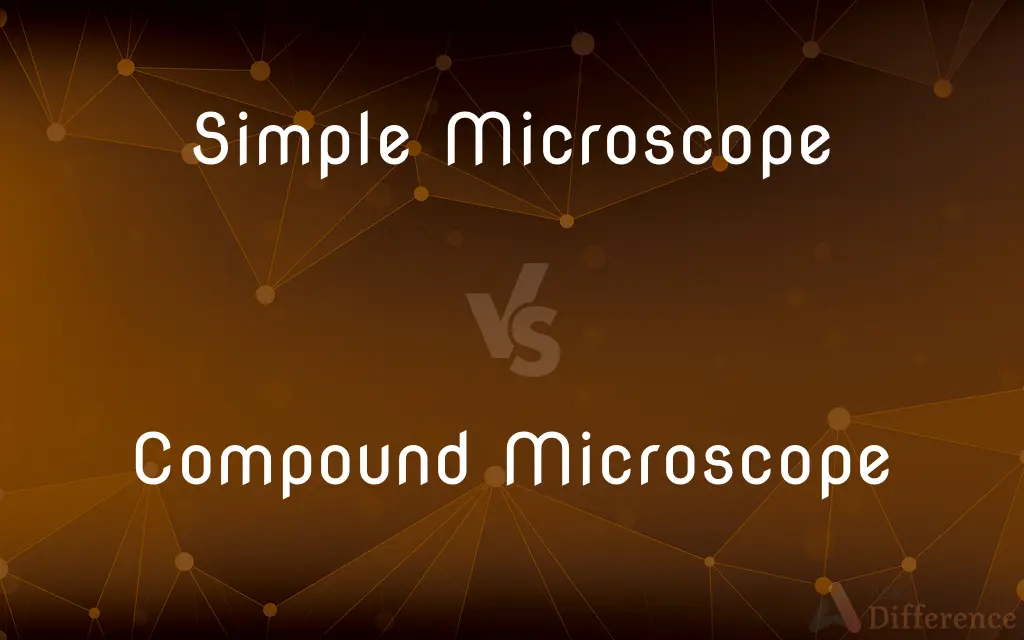Simple Microscope vs. Compound Microscope — What's the Difference?
By Tayyaba Rehman — Published on December 16, 2023
A Simple Microscope uses one lens for magnification, while a Compound Microscope uses multiple lenses for higher magnification and resolution. Both aid in viewing tiny objects, differing in complexity and capability.

Difference Between Simple Microscope and Compound Microscope
Table of Contents
ADVERTISEMENT
Key Differences
A Simple Microscope is essentially a magnifying glass, utilizing a single lens to magnify objects. On the other hand, a Compound Microscope employs a series of lenses, specifically an objective lens and an eyepiece, to provide higher magnification and more detailed views of specimens.
The design of the Simple Microscope is straightforward, making it portable and easy to use for basic magnification needs. The Compound Microscope, in contrast, is more intricate, equipped with features like a stage for holding slides and an illuminating light source.
In terms of magnification, a Simple Microscope offers lower levels of magnification compared to a Compound Microscope. The latter's ability to use multiple lenses in tandem allows it to achieve much higher magnification levels, revealing more minute details.
Another distinction between a Simple Microscope and a Compound Microscope is the clarity of the image. Compound microscopes, with their multiple lenses and light source, tend to offer clearer and brighter images, especially of transparent or translucent samples.
While both types of microscopes serve the primary function of magnifying objects, the Simple Microscope is best suited for observing larger particles or organisms. Meanwhile, the Compound Microscope excels at viewing cellular structures and other microscopic entities.
ADVERTISEMENT
Comparison Chart
Number of Lenses
One lens.
Multiple lenses (objective & eyepiece).
Magnification
Lower magnification.
Higher magnification.
Complexity
Basic and straightforward.
More complex with added features.
Image Clarity
Suitable for larger particles.
Clearer for microscopic entities.
Typical Use
Observing larger organisms or objects.
Viewing cellular structures, tissues.
Compare with Definitions
Simple Microscope
Basic microscope for direct magnification.
The jeweler used a simple microscope to inspect the gem's surface.
Compound Microscope
Advanced magnifying tool with high magnification.
Observing the bacterial colony was possible with the compound microscope.
Simple Microscope
A magnifying tool with a single lens.
I used a simple microscope to observe the texture of the leaf.
Compound Microscope
Instrument with objective and eyepiece lenses.
The compound microscope revealed the intricate details of the algae.
Simple Microscope
Single-lens instrument for viewing objects.
She peered through the simple microscope to study the insect's wing.
Compound Microscope
Microscope for detailed examination of minute samples.
With the compound microscope, the student explored the tissue sample.
Simple Microscope
The most basic form of magnifying instrument.
Under the simple microscope, the details of the fabric were evident.
Compound Microscope
Multi-lens system offering enhanced magnification.
The presence of microorganisms in the water was confirmed using a compound microscope.
Simple Microscope
Handheld device for slight enlargement.
With a simple microscope, the intricate patterns on the coin became visible.
Compound Microscope
Microscope with multiple lens systems.
The biologist used a compound microscope to examine the cell division.
Common Curiosities
Can a Compound Microscope view viruses?
Most viruses are too small for a typical Compound Microscope and require electron microscopes for observation.
What's the primary difference between a Simple Microscope and a Compound Microscope?
A Simple Microscope uses one lens, while a Compound Microscope uses multiple lenses.
Why does a Compound Microscope offer higher magnification?
The Compound Microscope employs both an objective lens and an eyepiece, multiplying their magnifications together.
Is a magnifying glass a Simple Microscope?
Yes, a magnifying glass is essentially a Simple Microscope as it uses one lens for magnification.
How is the image formed in a Compound Microscope?
The Compound Microscope forms an image using two lenses, the objective lens near the specimen and the eyepiece through which it's observed.
Which microscope is more suitable for students?
Beginners may start with a Simple Microscope, but a Compound Microscope offers more learning potential.
Are Simple Microscopes still in use?
Yes, they're used for basic magnification tasks, like reading small print or inspecting jewelry.
Can a Compound Microscope view live specimens?
Yes, live specimens can be viewed under a Compound Microscope, especially in wet mounts.
Can a Simple Microscope view cells?
Generally, a Simple Microscope has limited magnification, making it challenging to view individual cells.
Are there digital versions of both the Simple Microscope and the Compound Microscope?
Yes, digital versions exist for both, offering the ability to capture and analyze images on computers.
Why is the Compound Microscope called "compound"?
It's called "compound" because it uses a compound lens system, with multiple lenses working together.
Can a Simple Microscope be used for medical purposes?
While it can be used for basic observations, medical professionals often require the detail provided by Compound Microscopes.
How portable is a Simple Microscope compared to a Compound Microscope?
A Simple Microscope, like a magnifying glass, is more portable than most Compound Microscopes.
What's the magnification range of a typical Compound Microscope?
A standard Compound Microscope can have magnifications ranging from 40x to 1000x or more.
Which is more expensive, a Simple Microscope or a Compound Microscope?
Generally, a Compound Microscope is more expensive due to its complexity and features.
Share Your Discovery

Previous Comparison
Alcohol vs. Carboxylic Acid
Next Comparison
Indian Penal Code vs. Criminal Procedure CodeAuthor Spotlight
Written by
Tayyaba RehmanTayyaba Rehman is a distinguished writer, currently serving as a primary contributor to askdifference.com. As a researcher in semantics and etymology, Tayyaba's passion for the complexity of languages and their distinctions has found a perfect home on the platform. Tayyaba delves into the intricacies of language, distinguishing between commonly confused words and phrases, thereby providing clarity for readers worldwide.
















































